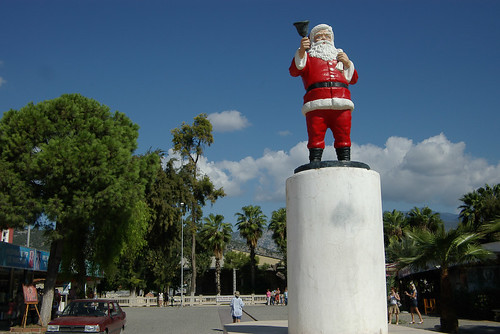Current Location: Finike, Turkey
Current Position: 36 17.63 N 30 08.98 E
Next Destination: Hanging here for the winter
With Christmas just around the corner I thought it was time for the truth to be known. First, Santa Claus is real - and he's from Turkey. Now, I grew up thinking good 'ol Saint Nick was from the North Pole. This jolly ol' guy wore thick red suits to stay warm and his cheeks were always rosy from the chill (or maybe the spiced hot chocolate). So imagine my surprise when I learned that all these years I had been lied to ... Santa Claus isn't from the North Pole, no sir, he's from right here in Turkey, about an hour drive from Finike - in the town of Myra (today known also as Demre)!
We had the pleasure of visiting Saint Nicholas' Church in Demre / Myra a few weeks ago. Unfortunately it was closed for the end of Ramadan (Muslim holiday), but we did get a chance to wander around the area and learn about the history of Santa Claus.

It all starts with Saint Nicholas - a 4th-century Greek Christian bishop of Myra. There are a couple of versions of how the gift-giving began but they are all centered around giving to others and helping the less fortunate. The story we heard (from our well informed guide) was that it started with Nicholas helping three impoverished daughters - providing them with dowries so that they could marry and not be sold into slavery or prostitution. As our guide tells it the first two daughters he helped by placing bags of gold through an open window (in the summer), but when it came time to help the third daughter it was winter so the window was closed. Nicholas therefore climbed up the roof and dropped the bag down the chimney, where, it so happens, the daughter's stockings were hanging to dry, and wouldn't you know it, the bag of gold fell right into the stocking!
Throughout his life Saint Nicholas was known for trying to help others and inspire good virtue. As legends of his unselfishness spread, the accounts of his deeds blended with regional folklore and eventually he was transformed into an almost mystical being who was known for rewarding the good and punishing the bad. He also became a patron saint to many children, orphans, and sailors who prayed for his compassion, guidance, and protection. His death (December 6th) was marked by an annual feast. On the eve before, children would set out food (for St Nicholas), straw (for the horses), and schnapps (for his attendants). The next morning, assuming they were "good" children, they would find their gifts replaced with sweets and toys.
From there Santa Claus, as we know him today, developed from many religious, cultural, and even commercial influences. Americans have the Dutch immigrants of the 1600's to thank for Santa Claus, originally introduced as Sinterklaas (meaning Saint Nicholas).
So why then does Santa Claus live in the North Pole? I mean where would you rather live - Turkey or some freezing, uninhabited, middle of nowhere place like the North Pole? And what about that red suit, the flying reindeer, and such? Most of these details come from creative writers and some commercialization. It starts around 1808 with the American author Washington Irving who wrote of an old St Nick riding over treetops in a horse drawn wagon, dropping gifts down chimneys. Irving also described Santa as a jolly Dutchman smoking a long stemmed pipe and wearing baggy breaches. In 1822 Dr Clement Clarke Moore, in "The Night Before Christmas", substituted eight reindeer and a sleigh for Irving's horse and Wagon - giving St Nick a more arctic background. Moore also gave Santa his broad face and round belly. Then in 1863, when Thomas Nast illustrated Moore's book of children's poems, he depicted a softer Santa dressed in red. In additional it was Nast that gave Santa a home - the North Pole. And finally we can thank artist Haddon Sundblom and Coca-Cola (in 1931) for adding the final touches to Santa's modern image. Sundblom's billboards for Coca-Cola featured a portly, jolly, grandfatherly-type Santa with rosy cheeks and a twinkle in his eye.
The terrific thing about Santa Claus is that he incorporates so many beleifs and traditions from around the world. And even though much of Santa may have come from the imaginations of writers, artists, and advertisers, the underlying truth of Santa is hard not to appreciate. Who doesn't like a man that represents goodness and kindness and attempts to help those around him in need? So from Billabong we wish you all a Happy St Nicholas Day!
Thursday, October 30, 2008
The Truth about Santa Claus
Subscribe to:
Post Comments (Atom)




actually,I had been there in summer 2008:)))
ReplyDelete